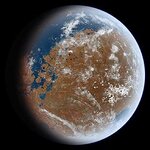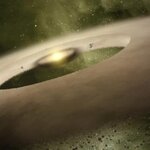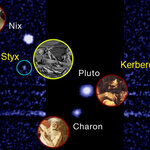Space

If the Sun's outer atmosphere - corona - is so hot, why does it always look so cool?
The Sun's visible surface is 'only' 10,000 degrees Fahrenheit, but as you move outward the temperature shoots up to millions of degrees. It's like a campfire that feels hotter the farther away you stand. That defies common sense, but so do dogs named Checkers and Esther Williams swimming pools so let's talk about coronal loops.
Coronal loops are shaped like an upside-down U and show where magnetic field lines are funneling solar gases or plasma. The best photos of the Sun suggest that these loops…

A new moon, designated S/2004 N 1, has been discovered orbiting the distant blue-green planet Neptune, the 14th known to be circling the giant planet.
S/2004 N 1 is estimated to be no more than 12 miles across, making it the smallest known moon in the Neptunian system. It is so small and dim that it is roughly 100 million times fainter than the faintest star that can be seen with the naked eye. It even escaped detection by NASA's Voyager 2 spacecraft, which flew past Neptune in 1989 and surveyed the planet's system of moons and rings.
Mark Showalter of the SETI Institute in Mountain View,…
For the first time, astronomers have measured the true colour of a planet in orbit around another star, and it is cobalt blue. This blue however, is probably the colour of a continuous rain of liquid glass, on a hot and windy planet. If you could make continuous observations of the overall colour of an exoplanet for half of its year, you could build up images of its surface. In the case of an Earth like exoplanet, you could map its continents, ice caps, cloud cover and any vegetation by the remarkable technique of Spin Orbit Tomography.
This new planet is HD 189733b. At 63 light years away,…

One day, perhaps, brave astronauts will set forth to colonize the planet Mars. However human colonies can't be sterilized in the way a rover can be, so they may conflict with the desires of astrobiologists to keep Mars biologically pristine. Would be colonists can find this hard to understand. What is so special about an apparently lifeless or almost lifeless planet?
To understand why many scientists value a pristine Mars so much, we need to look into its geological history.
Near twin in its early years
It seems likely that Mars had extensive oceans during its earliest Noachian period, which…

How did numerous small, glassy spherules become embedded within specimens of the largest class of meteorites, the chondrites? British mineralogist Henry Sorby first described these spherules, called chondrules, in 1877. Sorby suggested that they might be "droplets of fiery rain" which somehow condensed out of the cloud of gas and dust that formed the solar system 4.5 billion years ago.
Researchers have continued to regard chondrules as liquid droplets that had been floating in space before becoming quickly cooled, but how did the liquid form? "There's a lot of data that have been…

The International Astronomical Union, which declared itself the arbiter of names for the entire universe, is in hot water with "Star Trek" fans. A social media campaign, including endorsements by William Shatner and Leonard Nimoy, put Vulcan at the top of the list of polls aimed at naming two moons (P4 and P5) orbiting Pluto but the IAU vetoed it anyway, according to the SETI press release.
Well, they also once vetoed Pluto itself - that 2% of astronomers got rid of a whole planet is the only reason anyone has ever heard of the IAU. Their own arbitrary rules instead say Kerberos and Styx,…

The Solar Impulse airplane, brain-child airplane of Bertrand Piccard and André Borschberg (who co-piloted the entire journey) that can fly day and night without fuel or polluting emissions, has ended its cross-country journey in New York City. Solar Impulse is an unique adventure that seeks to put some emotion into solar power and also a flying laboratory to find innovative technological solutions for today’s solar challenges.
The carbon fiber airplane is the result of seven years of work, calculations, simulations and tests by a team of about 80 people and 100 partners and advisors. It…

Martian micro-organisms would be of extraordinary interest for the life sciences, especially if interestingly different from Earth life. In the past Mars was much more habitable than it is now, so most of the focus was on past life, and deep habitats beyond the reach of our rovers. Recent research suggests the intriguing possibility of life in tiny micro-habitats within the top few cms of soil and in some cases, right on the surface.
Mars sky at noon, imaged by pathfinder Might this apparently barren landscape harbour life?
Scientific opinion waxed and waned over the years. It was at its…

Spiral galaxies like our own Milky Way appear to be much larger and more massive than previously believed, according to new observations made with Hubble's Cosmic Origins Spectrograph.
The observations found that normal spiral galaxies are surrounded by halos of gas that can extend to over 1 million light-years in diameter. The current estimated diameter of the Milky Way, for example, is about 100,000 light-years. One light-year is roughly 6 trillion miles. The material for galaxy halos detected by study leader Professor John Stocke of the University of Colorado Boulder and his team…

All stars begin their lives in groups, though most, including our Sun, are born in small, benign groups that quickly fell apart. Others form in huge, dense swarms that survive for billions of years as stellar clusters.
Within such rich and dense clusters, stars jostle for room with thousands of neighbors while strong radiation and harsh stellar winds scour interstellar space, stripping planet-forming materials from nearby stars.
That's an unlikely place to find alien worlds.
Yet 3,000 light-years from Earth in the star cluster NGC 6811, astronomers have found two planets smaller than…